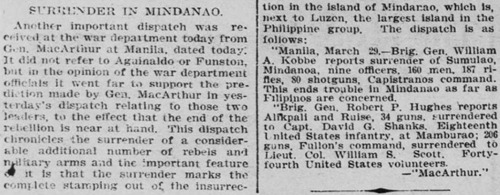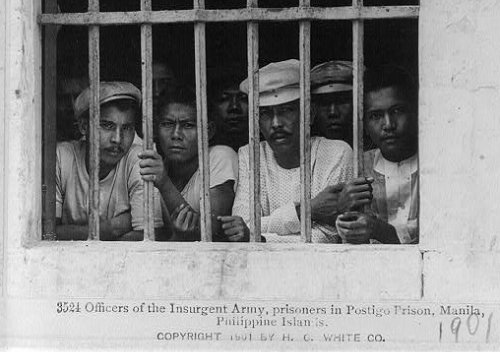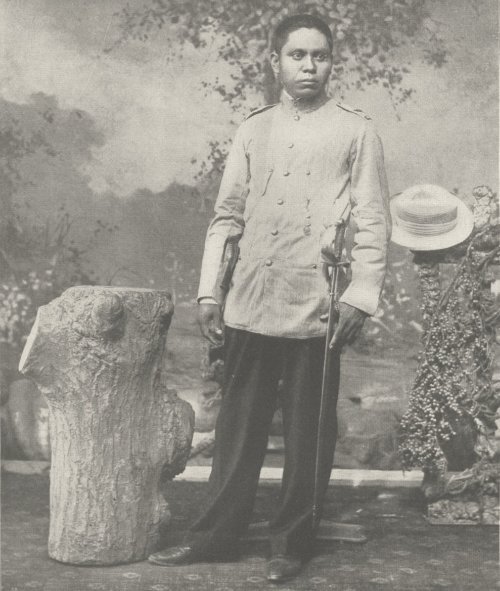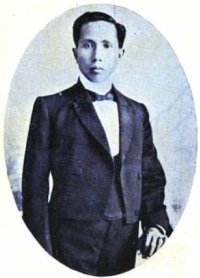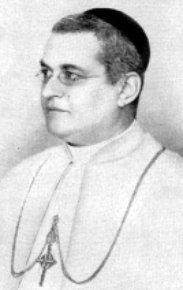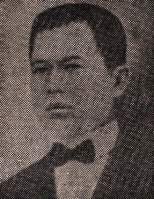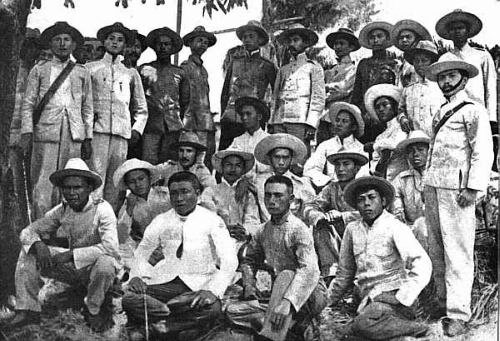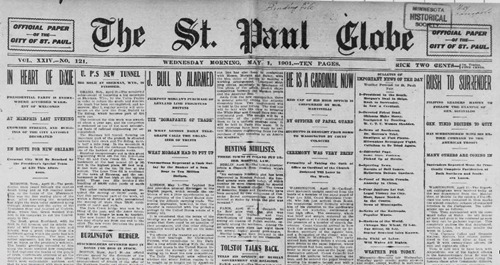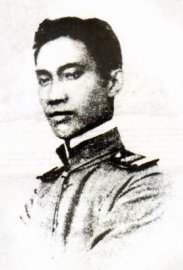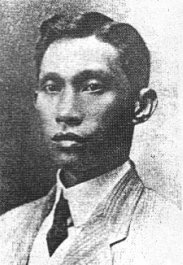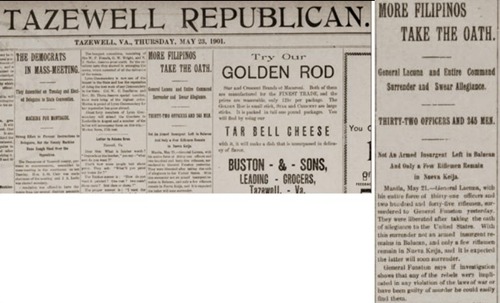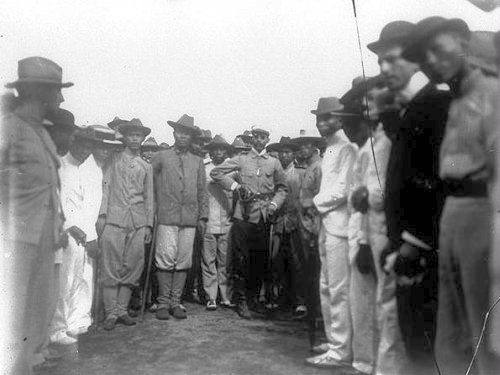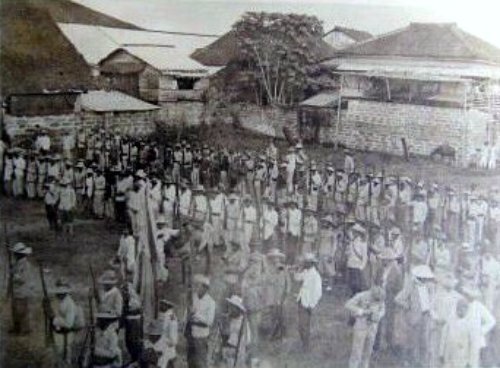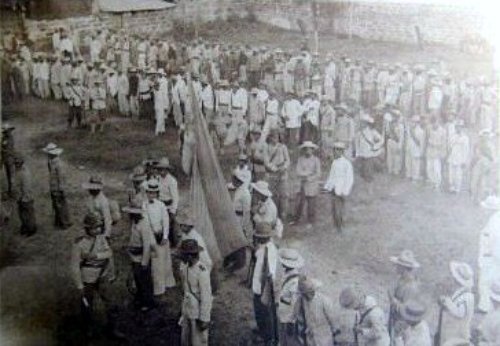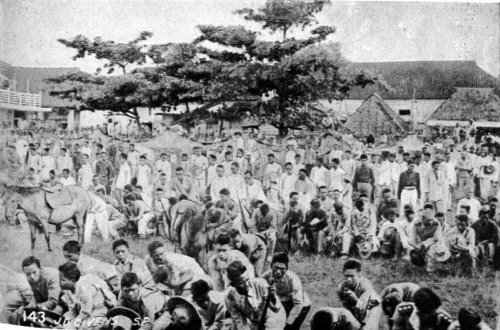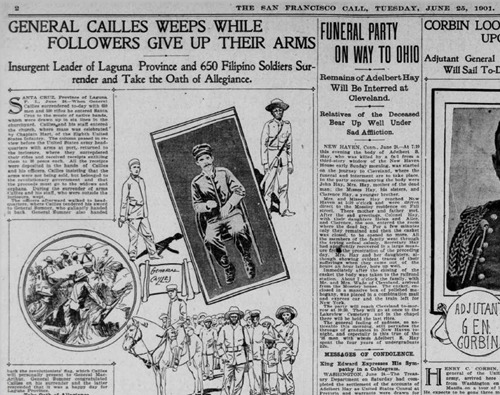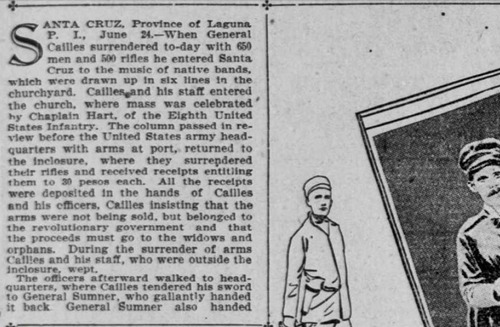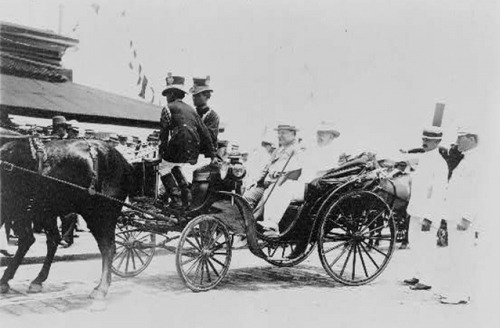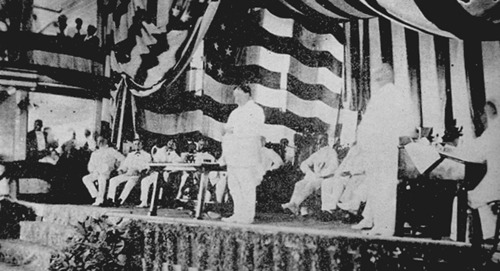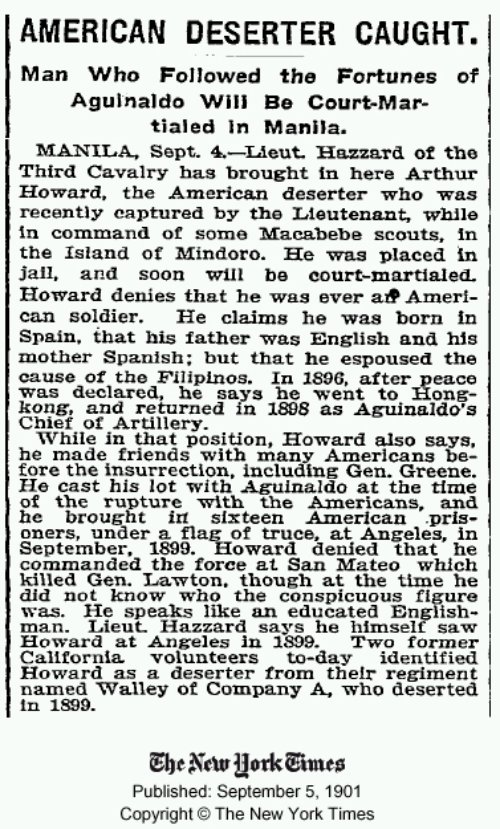Collapse, 1901: General Capistrano surrenders in Sumilao, Bukidnon, March 29, 1901
On March 29, 1901, General Nicolas Capistrano, commander of Filipino guerilla forces in northern Mindanao Island, surrendered in Sumilao, Bukidnon Province; the highland town is approximately 62 kilometers from Cagayan de Misamis (now Cagayan de Oro City). He gave up with 9 officers and 160 men, and turned in 187 rifles and 80 shotguns.
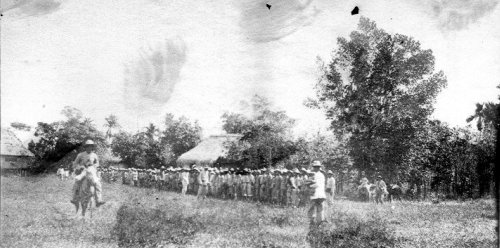
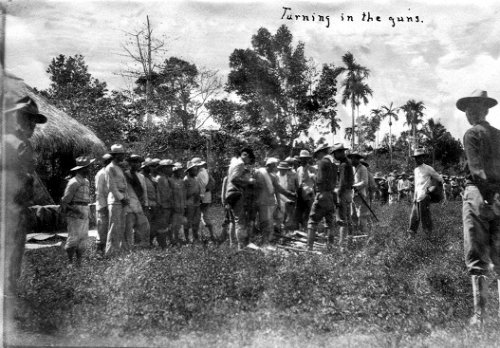
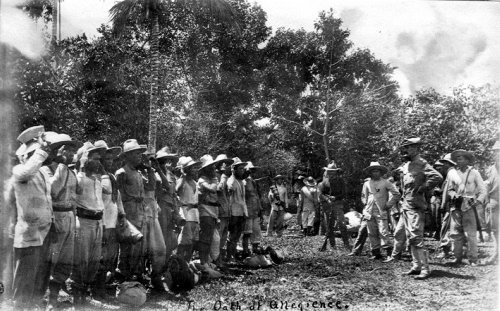
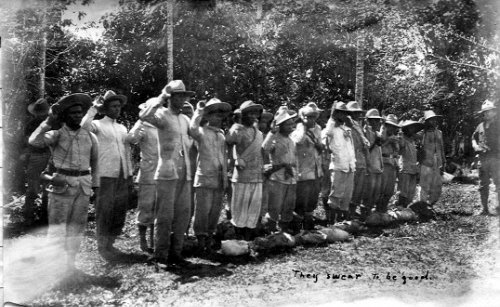
General Capistrano was born on Jan. 7, 1864 in Angat, Bulacan Province, Luzon Island. He and his wife migrated to Cagayan de Misamis in the late 1890’s.
He was later elected into the Philippine Assembly of 1909, and served in the Philippine Senate from 1916 to 1919.
March 30, 1901: Gen. Licerio Geronimo surrenders in San Mateo, Morong Province
Gen. Licerio Geronimo commanded the Filipino force that killed Maj. Gen. Henry Ware Lawton at the battle of San Mateo on Dec. 19, 1899.
Arturo Dancel, a member of the pro-American Partido Federal, convinced Geronimo to surrender.
On March 30, 1901 Geronimo gave up in San Mateo with 12 officers, 29 men and 30 guns. He initially surrendered to Capt. Duncan Henderson, CO of Company E, 42nd Infantry Regiment of U.S. Volunteers, who presented him to Col. J. Milton Thompson, the regimental commander.
Shortly afterward, Geronimo joined the Partido Federal. [PHOTO, right, Geronimo in his 60’s].
Geronimo became one of a handful of Filipinos admitted into the officer ranks of the colonial Philippine Constabulary (PC). He enlisted on June 1, 1902 and resigned on May 16, 1904.
He was born on Aug. 27, 1855 in Sampaloc district, Manila and died on Jan. 16, 1924. He was 68 years old.
[For more on Licerio Geronimo, see section in this website entitled “The War Rages, 1899”]
General Ludovico Arejola surrenders in Camarines, March 31, 1901
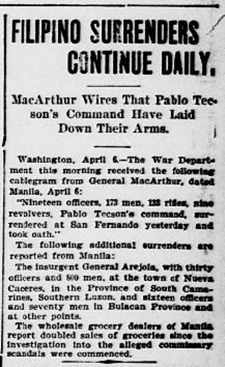
The two American officers went unescorted to Arejola’s encampment at Bulawag, about 6 miles up the river from Minalabac, and negotiated his surrender.
They escorted Arejola to Nueva Caceres (now Naga City) where Arejola formally gave up to Col. Edward Moale, CO of the 15th US Infantry.
General Arejola surrendered with 30 officers (1 Colonel, 3 Lt. Colonels, 5 Majors, 21 junior officers) and 800 men. They turned in 43 rifles, 12 revolvers and hundreds of bolos (machete-like bladed weapons).

Arejola was appointed as Coronel de la Milicia Territorial by President Emilio Aguinaldo. He was tasked with organizing the milicias in Ambos Camarines and Catanduanes. He later rose to the rank of General.

In January 1900, the Americans landed in Camarines Sur, not so much to end resistance in the Bicol region, but to open the hemp ports from which flowed the abaca fibers very much in demand in the American market. General Arejola engaged the Americans at Agdangan, Baao town. Afterwards he set up a camp in the mountains of Minalabac. The resistance also included an eight-woman group, called the Damas Benemeritas de la Patria, that tended to the injured and the sick, and brought clothes and provisions to the Bicolano guerillas.
Additional American troops disembarked in Calabanga, Camarines Sur, on Feb. 19, 1900.
Relentless American operations, battle casualties, rampant illness in the ranks, acute lack of firearms and ammunition, and atrocities perpetrated by US soldiers on innocent civilians weighed heavily in the decision of General Arejola to give up the fight.
April 11, 1901: Aguinaldo’s Aides, Col. Simeon Villa and Dr. Santiago Barcelona, are released
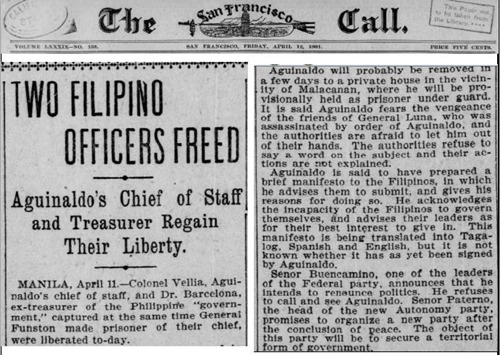
April 17, 1901: Col. Maximo Abad surrenders in Marinduque
In photo above, Colonel Maximo Abad, chief of Filipino forces in the island province of Marinduque, is being accompanied to Boac by Colonel Harry Hill Bandholtz of the Philippine Constabulary.

On April 17, 1901, Abad surrendered to Major Frederick A. Smith, inspector-general of the US Army, with 9 officers and 70 men. The oath of allegiance to the United States was administered with great ceremony on the plaza at Boac, capitol of Marinduque.
The rest of Abad’s command soon followed suit. Captain Pedro Torres gave up in Torrijos on April 24, 1901 with 2 officers and 42 men, with 2 revolders, 38 rifles and 360 rounds of ammunition. Lieutenant Alciano Pareno surrendered on April 26, 1901 at Santa Cruz, with 52 men and turned over 1 revolver, 32 rifles and 240 rounds of ammunition. This terminated active hostilities in the island.
One of only five battles that the Filipinos won in the Filipino-American war was the Battle of Pulang Lupa in present-day Barangay Bolo, Torrijos, a mountainous part of Marinduque overlooking Tayabas Bay, Mongpong Pass and Tablas Strait. On September 13, 1900. Colonel Abad and his men ambushed a detachment of 54 soldiers from Company F, 29th U.S. Volunteer Infantry, led by Captain Devereux Shields, killing 4 and forcing the rest to surrender.
April 19, 1901: Aguinaldo Calls on Filipinos to Surrender
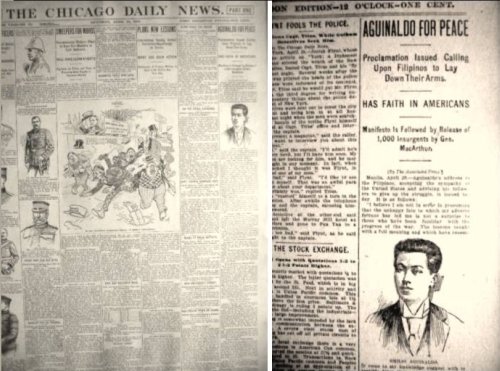
“To the Filipino People:
“I believe that I am not in error in presuming that the unhappy fate to which my adverse fortune has led me is not a surprise to those who have been familiar day to day with the progress of the war. The lessons thus taught, the full meaning of which has recently come to my knowledge, suggested to me with irresistible force that the complete termination of hostilities and a lasting peace are not only desirable but absolutely essential to the welfare of the Philippines.
“The Filipinos have never been dismayed by their weakness, nor have they faltered in following the path pointed out by their fortitude and courage. The time has come, however, in which they find their advance along the path impeded by an irresistible force – a force which, while it restrains them, yet enlightens the mind and opens another course by presenting to them the cause of peace, This cause has been joyfully embraced around glorious and sovereign banner of the United States. In this manner they repose their trust in the belief that under its protection our people will attain all the promised liberties which they are even now beginning to enjoy.
“The country has declared unmistakably in favor of peace; so be it. Enough of blood; enough of tears and desolation. This wish cannot be ignored by the men still in arms if they are animated by no other desire than to serve this noble people which has clearly manifested its will.
“So also do I respect this will now that it is known to me, and after mature deliberation resolutely proclaim to the world that I cannot refuse to heed the voice of a people longing for peace, nor the lamentations of thousands of families yearning to see their dear ones in the enjoyment of the liberty promised by the generosity of the great American nation.
By acknowledging and accepting the sovereignty of the United States throughout the entire Archipelago, as I now do without any reservations whatsoever, I believe that I am serving thee, my beloved country. May happiness be thine! ”
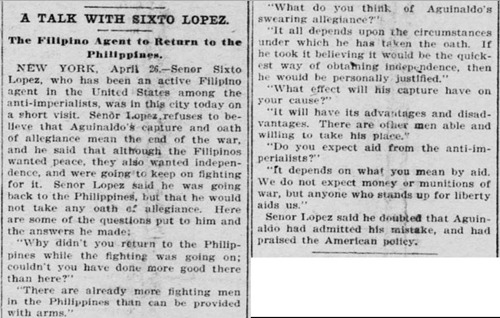
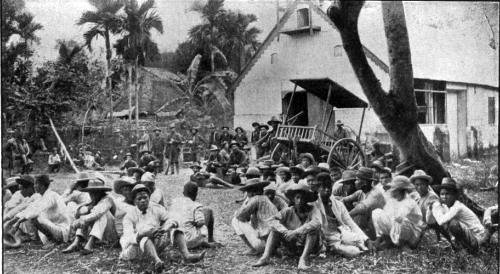

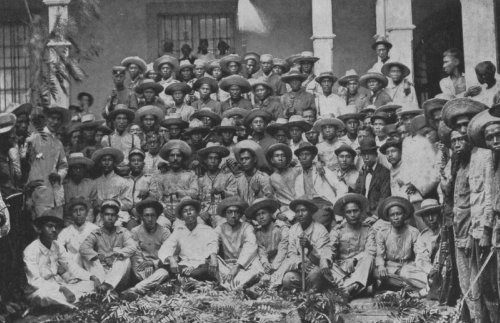


He described how it was administered: “The spy was held flat on his back on the ground, a bamboo or other strong hollow tube was forced between his teeth, and he was slowly poured uncomfortably and sometimes dangerously full of water.”
He rationalized that “since the victim has it in his own power to stop the process, or prevent it altogether by divulging what he knows before the operation has gone far enough to seriously hurt him,” the “water cure” technique cannot be accurately labeled “torture.”
He went on: “If the violent critics of this method of gaining information could put themselves in the places of soldiers in lonely and remote bamboo jungles, I fancy they would feel differently….The matter would not look as it does here divorced from the stern conditions of warfare with a treacherous enemy.”
Stuntz confessed to having personally witnessed the army administering the “water cure” to several Filipinos. He came to Manila in March 1901 with wife Estelle Clark; prior to his Philippine assignment, he did missionary work in India for 7 years.
On May 16, 1912, he was elected Bishop by the General Conference of the Methodist Episcopal Church in session in Minneapolis, Minnesota.
April 24, 1901: General Isidoro Torres surrenders in Bulacan
General Isidoro Torres, with 6 of his men, surrendered on April 24, 1901 to Capt. James H. McRae of the 3rd US Infantry in Norzagaray, Bulacan Province. In October 1901, a Corporal Fieldner of the 12th US Infantry was assassinated in Malolos, Bulacan. A US military commission tried and found Torres guilty of ordering the assassination; in early December 1901, he was sentenced to be hanged. However, Maj. Gen. Adnan Chaffee disapproved the sentence; he said the commission had reasonable grounds whether Torres personally ordered the assassination. Chafee thought that “the high rank held by General Torres in the insurgent army would have been sufficient to prevent such an unmilitary action on his part.”
Torres was born on April 10, 1866 to an affluent family in Matimbo, Malolos, Bulacan Province. He completed secondary schooling in the Colegio de San Juan de Letran and obtained his Bachelor of Arts from the Universidad de Santo Tomas.
In 1882, at age 16, he was involved in a plot to kill Father Moises Santos, the parish priest who imposed exorbitant church fees. He was arrested and tried but due to the high social standing enjoyed by his family, he was exonerated.
He joined the Katipunan in 1892, and together with Deodato Arellano, Doroteo Karagdag, Juan de Leon and Manuel Crisostomo, they organized the Sangguniang Lalawigang Balangay Apoy, a chapter of the Katipunan in Bulacan.
When the secret society was discovered in August 1896, he narrowly escaped arrest. He fled to Masukol, Paombong, Bulacan where he gathered 3,000 men from Hagonoy and Tondo.

During the Philippine-American War, he took part in the second battle of Manila on Feb. 22-23, 1899 and waged guerilla warfare until his surrender.[LEFT, The Times, Washington, D.C., April 27, 1901, Page 1].
The Americans offered him the governorship of Bulacan but he declined. Instead, he sailed for Singapore, then Japan where he stayed for sometime. He returned in 1903 and moved to San Antonio, Nueva Ecija Province where he became justice of the peace from 1910 to 1912.
He was elected municipal councilor and later delegate to the Philippine Assembly.
Torres died on Dec. 5, 1928 at age 62.
April 27, 1901: Abra resistance leaders surrender
Juan and Blas Villamor (ABOVE), cousins and leaders of Filipino resistance forces in Abra Province, surrendered at Bangued on April 27, 1901.
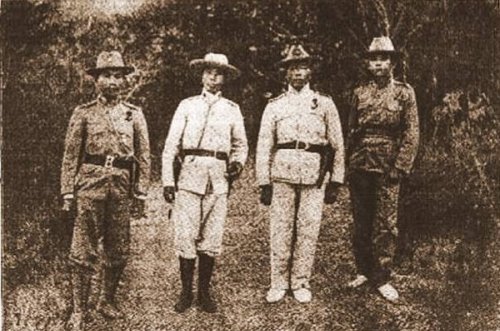


The Spanish friars compelled him to join the Spanish Army during the revolution of 1896; he became a prisoner of the Revolutionary Army in Bataan, and was later recruited and assigned by Apolinario Mabini to the editorial staff of El Heraldo de la Revolucion, then published in Malolos.
In 1899, he joined the forces of General Manuel Tinio; he was given the rank of colonel of infantry. He continued his journalistic career, as editor of La Nueva Era, after the war with the United States.
He was provincial governor of Abra, 1902-04., honorary commissioner to the United States at St. Louis Exposition, 1904; member of the first Philippine Assembly from the 3rd district of Ilocos Sur, 1907-12 (RIGHT, in 1907); provincial governor of Ilocos Sur, 1912-16; and Senator from 1916-19. He is the author of the book entitled: �General Antonio Luna y Novicio.�
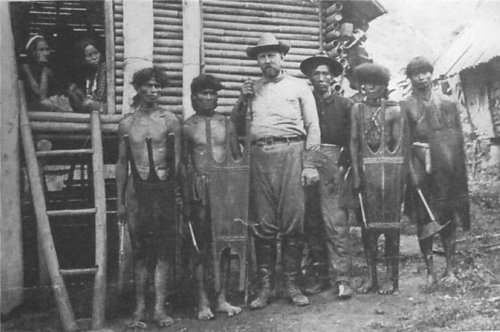
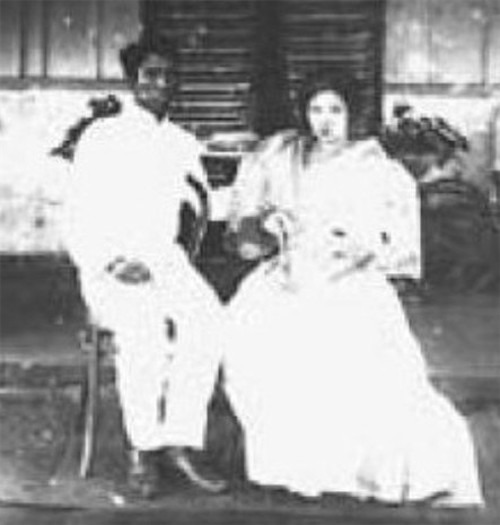
April 28, 1901: Gregorio Aglipay surrenders in Ilocos Norte
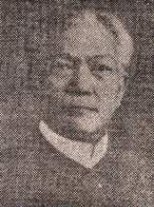
Older than Tinio, a university graduate, an ordained priest, and a proud Ilocano patriot, he found it impossible to take orders from the younger Tagalog university dropout. But they shared a determination to resist the American occupation.
Aglipay never held a military commission but quickly became a legend by galloping into battle on a large American horse. Aglipay’s own followers earned a reputation for throwing themselves into battle with the suicidal abandon of religious fanatics.
In 7 encounters during the period April 16-25, 1900, 453 of them died in action, mostly in hand-to-hand combat in Vintar, Laoag and Batac.
The 2 heaviest battles took place in or near Batac. On the 17th, 180 Filipinos were killed; on the 25th, 120 of Aglipay’s men died.
In these 7 engagements, the Americans suffered only a total of 3 men killed.
Gregorio Labayan Aglipay was born on May 8, 1860 in Batac, Ilocos Norte. He studied Law at the Colegio de San Juan de Letran and Universidad de Santo Tomas in Manila. After obtaining his law degree, he entered the seminary in Vigan, Ilocos Sur Province in 1883 and was ordained a Roman Catholic priest in 1890.
Six years later, he joined the revolution against Spain and called on Filipino priests to rally to the side of the rebels; he also proposed the creation of a council that would work for the Filipinization of the Roman Catholic Church in the Philippines while retaining its loyalty to the Vatican.
He represented Ilocos Norte in the first Philippine Congress convened in Malolos, Bulacan on Sept. 15, 1898. Gen. Emilio Aguinaldo, president of the Revolutionary Government, appointed him as military vicar general on Oct. 20, 1898.

Father Bernardino Nozaleda (LEFT), Archbishop of Manila, excommunicated Aglipay on May 5, 1899.
Nozaleda was born on May 6, 1844 in Cuenya-Nava, Spain. On Oct. 13, 1861, he was professed as a member of the Order of Friars Preachers. He was appointed archbishop of Manila on May 27, 1889. He issued circulars to the Filipinos on May 8, 1898 urging them to defend the Philippines against the American invaders. On Feb. 4, 1902 he resigned as Manila archbishop and returned to Spain. On Nov. 14, 1904. he was appointed Archbishop of Valencia. He died on Oct. 7, 1927.
When the Philippine-American War broke out, Aglipay served as a guerilla leader in the Ilocos region.

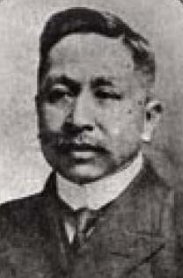
Aglipay headed the new church a month later.
On May 3, 1918, Aglipay became a Freemason, and in October 1925 rose to the 32nd degree.
The church is now often referred to as the Aglipayan Church. Aglipay continued to fight for the independence of the Philippines and ran for president of the commonwealth in 1935, but lost to Manuel Quezon. He married in 1939 (the new church allowed married clergy) but died the following year on Sept. 1, 1940. He was 80 years old.

The late historian Teodoro A. Agoncillo described the Aglipayan Church as �the only living and tangible result of the (1896) Revolution.�
April 29, 1901: General Jose Alejandrino surrenders in Pampanga
General Jose Alejandrino surrendered on April 29, 1901 in Arayat, Pampanga, to Brig. Gen. Frederick Funston. The latter initially refused his offer to surrender and, instead, had him placed under arrest, demanding that he present a certain Black American soldier named David Fagen, who was wanted for desertion. Although he resisted Funston�s demand, Alejandrino was released the next day.
Alejandrino (RIGHT, in 1898) was born to a wealthy couple from Arayat, Pampanga on December 1,1870, in Binondo, Manila. He studied at the Ateneo Municipal de Manila and, thereafter, at the Universidad de Santo Tomas, where he acquired a Bachelor of Arts degree. He pursued his studies in Spain and at the University of Ghent in Belgium, where he graduated with a degree in chemical engineering.
While in Spain, he became an active member of the Propaganda Movement. A close friend of Jose Rizal, he was the one who brought the manuscript of the El Filibusterismo to the printing press for publication.
In 1898, he served in the Malolos Congress that was first convoked on September 15 by the revolutionary government. Later, he was designated chief of engineers of the army by President Emilio Aguinaldo.When the Philippine-American War erupted, he affiliated with Gen. Antonio Luna.
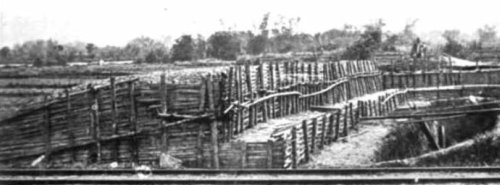
Alejandrino directed the building of trenches in several areas, including Caloocan and Bulacan . He rose to brigadier-general and served as acting secretary of war. He was also appointed commanding general of the military operations in Central Luzon and military governor of Pampanga. By then the beleaguered government of Aguinaldo had been continuously hounded by the pursuing American forces and pushed back to Tarlac.
In August 1901, he accepted from Gov. William H. Taft the position of second city engineer of Manila, but discharged his duties for not more than a year. He retired to lead a farmer�s life until 1925, when he was designated senator for Sulu and Mindanao by Gov. Gen. Leonard Wood. A member of the Partido Democrata Nacional, he was elected representative of Pampanga�s second district to the Constitutional Convention in 1934.
Alejandrino (LEFT, in old age) died on June 1, 1951 at age 80.
April 29, 1901: General Baldomero Aguinaldo surrenders in Cavite
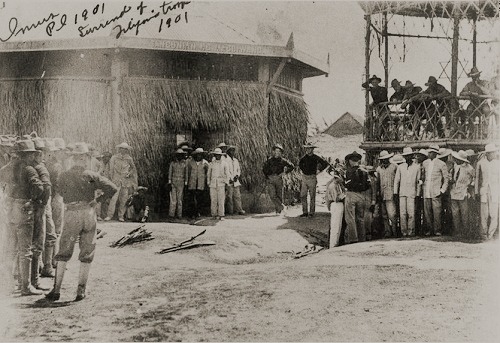
General Baldomero Aguinaldo (LEFT) surrendered in Cavite Province on April 29, 1901, along with Colonels Pedro Aguinaldo, Sixto Macapagal, Lazaro Macapagal (RIGHT) and 4 captains and 7 lieutenants. [Lazaro Macapagal, then a Major, was the executioner of Katipunan Supremo Andres Bonifacio and his brother Procopio on May 10, 1897]
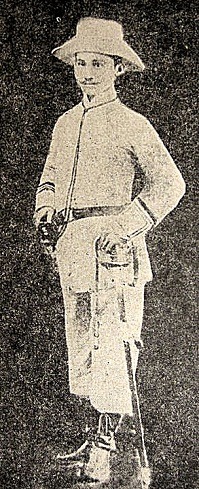
He studied law at the Universidad de Santo Tomas and was still a law student when the Philippine Revolution broke out on Aug. 30, 1896. He obtained a law degree, but failed to take the bar examination. Unable to practice law, he became a farmer.
Aguinaldo organized, along with his cousin Emilio, and the Tirona brothers, Candido and Daniel, the Magdalo faction of the Katipunan in Kawit. As a general, he figured in the bloody battles at Binakayan, Dalahican and Noveleta on Nov. 9-10, 1896; in Zapote on Feb. 17, 1897; in Salitran on March 7 of the same year; and in Alapan, Imus on May 28, 1898.
He served as Judge Advocate General (Auditor de Guerra) in the court-martial of the Bonifacio brothers Andres and Procopio. He reviewed the decision of the Council of War headed by General Mariano Noriel and forthwith transmitted the papers including his recommendation to General Emilio Aguinaldo on May 8, 1897. The sentence was death by firing squad. The brothers were shot on May 10, 1897.
Aguinaldo’s knowledge of law and administrative procedures made him a valuable asset to the revolutionary government. He was appointed to several cabinet positions, and was a signer of two important documents: the Biyak-na-Bato Constitution and the Pact of Biak-na-Bato. He accompanied General Emilio Aguinaldo to Hongkong, as a voluntary exile, on Dec. 27, 1897.

During the Philippine-American War, Aguinaldo commanded Filipino forces in the southern Luzon provinces. After the cessation of hostilities, the general retired to private life and devoted his time to farm work, particularly the supervision of his coconut plantation in Silang, Cavite.
When the Asociacion de Veteranos de la Revolucion was organized in 1912, Baldomero became its first president and remained so until his death in Malate, Manila at age 46 on Feb. 4, 1915, a victim of heart failure and rheumatism.. His remains were buried at the Mausoleum of the Veterans of the Philippine Revolution at the Manila North Cemetery.
May 1, 1901: General Manuel Tinio surrenders in Ilocos Sur
On May 1, 1901, obeying Aguinaldo’s appeal, General Manuel Tinio (6th from Right, last row, PHOTO) gave up with his 36 officers. He came out of Barrio Maradodon, Cabugao, Ilocos Sur and surrendered to General James Franklin Bell in the nearby town of Sinait. General Arthur MacArthur reciprocated by releasing 1,000 Filipino POWs.
Tinio was born in Aliaga, Nueva Ecija on June 17, 1877, to one of the province�s landed and richest families. He was educated at the Colegio de San Juan de Letran in Manila. In April 1896, at the age of 18, he joined the secret revolutionary society Katipunan. When the revolution broke out in August 1896, he dropped out of school and took to the field. On June 6, 1897, he was conferred the rank of colonel and the command of a brigade, which became famous as the “Tinio Brigade“. He engaged the Spanish army in Nueva Ecija and Bulacan.
Tinio, not Gregorio del Pilar, was the youngest Filipino general. He was promoted to General de Brigada on Nov 11, 1897 when he was only 20 years old (PHOTO, right). Del Pilar was still a lieutenant colonel at the time. (Del Pilar became a general either in June or July 1898 at age 22).
By virtue of the Truce of Biyak-na-Bato of Dec. 14, 1897, he and other revolutionary leaders went to Hongkong as exiles. Shortly after he and the other exiles returned to the Philippines on May 19, 1898, he was appointed to lead an expedition to Northern Luzon.
Within 15 days —- and initially armed with 300 Mauser rifles he captured from the Spaniards in Hagonoy, Bulacan Province —- he gained control of the provinces of La Union, Ilocos Sur, Abra, Ilocos Norte, Benguet, Tiagan, Amburayan, Lepanto, Bontok and four towns of Cagayan. He met resistance only in San Fernando, La Union and Aparri, Cagayan. In these provinces, Tinio captured 3,000 guns.
On Aug. 14, 1898, he occupied Vigan. Upon his arrival, the friars including the Archbishop of Nueva Segovia, Msgr. Jose Hevia Campomanes, escaped by boat to Aparri.
He used the Palacio de Arzobispado de Nueva Segovia at Vigan, Ilocos Sur, the former residence of the Spanish archbishop, as his headquarters.
His chance to fight the Americans came in connection with the retreat of General Emilio Aguinaldo and his men to the north, beginning on Nov. 13, 1899.
After his surrender, Tinio married his girifriend Laureana Quijano from Sinait and returned to his home province of Nueva Ecija.
He served as provincial governor from 1907 to 1909 (PHOTO at left, as Governor) and he named one Nueva Ecija town Laur, his wife’s nickname.
On July 1, 1909, he was appointed by Governor General James F. Smith as the first director of the Bureau of Labor. On Oct. 17, 1913, he was appointed Director of Lands, the first Filipino to occupy the position which he held up to 1914.
After leaving the government service in 1914, Tinio toured Europe. Upon his return he entered politics and headed the Nationalista Party in Nueva Ecija.
He died on Feb 22, 1924 at the age of 46, of cirrhosis of the liver. His ailment was attributed to his fondness for Tres Cepas brandy, a bottle of which he consumed after every meal.

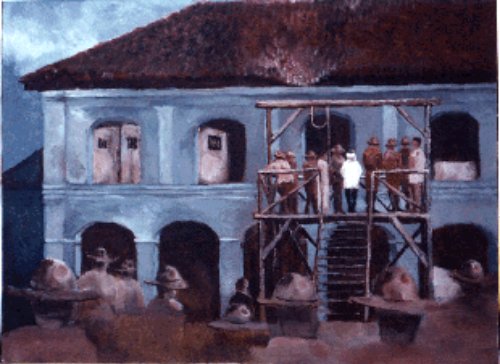
One of Tinio’s officers, Maj. Francisco Celedonio, was hanged by the Americans on Aug. 30, 1901. He was tried and convicted for the abduction and unjustified summary executions of Cabugao Presidente Municipal Basilio Noriega and his son-in-law Benigno Sison on Dec. 20, 1899. Celedonio had accused Noriega of being pro-American; in truth, the latter was condemned by informers who held personal grudges against him. Sison, an innocent bystander who witnessed Noriega’s abduction, was taken along for simply being there. Sison’s wealthy family was actually the biggest contributor to the Filipino war effort in Cabugao.
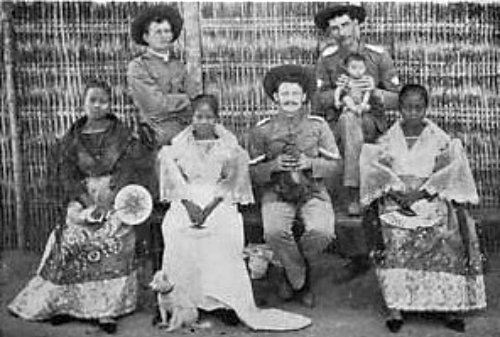
An Italian-American who engaged Tinio in battle, George Barbers (original surname: “Barbieri”) of the US Third Cavalry, stayed in Cabugao, traded his horse for a motorcycle, went into the transportation business, and married his sweetheart, Silvestra Guerrero. He never returned to the US. His direct descendants include Police General and Manila Vice Mayor (1988-1992) James Barbers, Police General and Senator (1998-2002) Robert Z. Barbers, Surigao del Norte Province Governor (2001-2004) Robert L. Barbers, and Congressman and Surigao del Norte Province Governor (still serving as of 2008) Robert Ace Barbers.
Barbers’ comrade, James Wingo, Sr., married Silvestra’s sister, Maura Guerrero, had a son named James, Jr., and was recalled by the army to the US where he died while waiting to return to Cabugao. James, Jr., an Ernie Pyle award-winning war correspondent, revisited his birthplace in 1945. His other son, Walter, became a journalist on the staff of The Washington Post and later became editor of the U.S. News and World Report.
May 18, 1901: General Ambrosio Mojica surrenders in Leyte
General Ambrosio Mojica surrendered at about 7:00 p.m., on Saturday, May 18, 1901 in Baybay, Leyte, with 4 lieutenants, 20 men and 3 revolvers. The officers were: 1Lt. Ricardo Ruiz, 1Lt. Rodrigo Cruz del Rosario, 2Lt. Anselmo Ateredo and a Second Lieutenant Estanislao. Mojica’s bodyguard of 10 riflemen —- who refused to give up the fight —- had deserted Mojica the previous night.
Mojica and his men surrendered to Maj. John C. Gilmore, Jr., commanding officer of the 43rd Infantry Regiment of U.S. Volunteers.
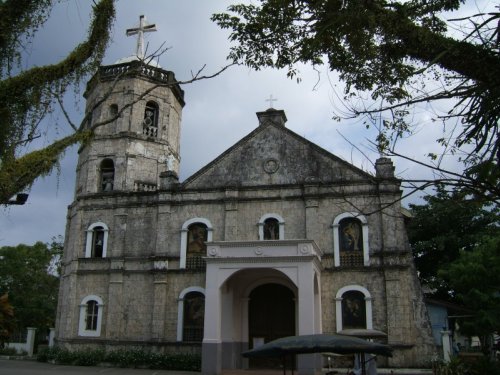
They took the oath of allegiance after church the following day, Sunday, in the presence of several hundred people. After the oathtaking, without being asked to do so, Mojica turned over $14,133.39 in Spanish Mexican notes (read the “$” sign as “Pesos”). He explained that he had collected the money represented by these notes as customs duties before the arrival of the Americans and had been exchanged for the notes.
Major Gilmore, in his official report, wrote of Mojica : “He impressed me very favorably —- a man of considerable intelligence and much more honest than the general run of insurgents.”
Mojica was born to a middle-class family on May 3, 1853 in Barrio Buna, Indang, Cavite Province. He went to a private school in the town and then continued his studies in Manila.
He was 43 years old when the Revolution broke out, many years older than the majority of revolutionary generals who were in their early or late twenties. He defeated the Spaniards in Alfonso, Cavite and Balayan, Batangas.
Mojica was appointed by Aguinaldo as politico-military governor of Leyte during the First Philippine Republic. He spent much time undertaking public works projects in the province, and soon the Leyte�os began to cooperate with him as if he was a native son of the province.
When the Philippine-American War ended, he became a councilor of Indang. He died at the age of 55 in 1908.
May 19, 1901: General Urbano Lacuna surrenders in Nueva Ecija
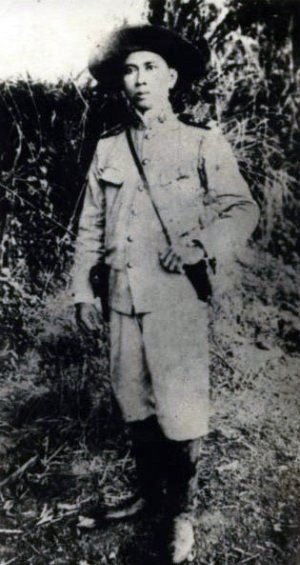
Two of Lacuna’s officers, his adjutant Maj. Timoteo Dhalan and Lt. Manuel Gonzales, were hanged on Nov. 8, 1901 for the murder of Jose Buencamino, the pro-American Presidente Municipal of San Miguel de Mayumo, Bulacan Province, and 5 American soldiers.
The previous year, on Oct. 30, 1900, a detachment of 10 American soldiers of the 35th Infantry Regiment, U.S.V., acting as escort for Buencamino, the newly elected mayor of San Miguel de Mayumo, was ambushed near the Maasim River by Dhalan’s guerillas. Buencamino and 5 of the Americans were captured.
Dhalan issued Gonzales a written order to execute the prisoners. Buencamino and the Americans —- Privates Elmer Dane, John Hickman, Hamlet Jarvis, William Smith and Frank Wilson —- with their arms tied behind their backs, were stabbed to death.
During the trial of Dhalan, Lacuna was introduced as an unwilling witness for the prosecution; he was brought up for the purpose of identifying the handwriting of the execution letter. When he was asked if he recognized the penmanship of the letter as that of Dhalan, he hesitated, looked helplessly around, and finally in a barely audible voice answered, “I do.” Brig. Gen. Frederick Funston wrote: “It was an intensely dramatic and very painful moment, and all of us felt keenly sorry for the old guerilla chief, placed in the position of having to take his choice between committing perjury or assisting in weaving the web about a former staff officer.”
It was General Lacuna’s forged signature that led to the capture of Emilio Aguinaldo at Palanan, Isabela Province, on March 23, 1901. A letter, allegedly from him, stated that in accordance with instructions from General Baldomero Aguinaldo, he was sending eighty men to Palanan under the command of Tal Placido, Lazaro Segovia, and Cecilio Segismundo.
This message was consistent with instructions contained in captured messages decoded by Brig. Gen. Frederick Funston and his staff in San Isidro, Nueva Ecija. These men, actually Macabebe Scouts in the US Army, entered Aguinaldo’s hideout without difficulty. They seized the unsuspecting Aguinaldo at the first opportune moment.
Lacuna was born in Pe�aranda, Nueva Ecija on May 25, 1862. He received his early education in Gapan, Nueva Ecija and completed a teaching course at the Escuela Normal in Manila. He died of a kidney problem on April 10, 1911. He was nearly 49 years old.
May 20, 1901: General Tomas Mascardo surrenders in Zambales
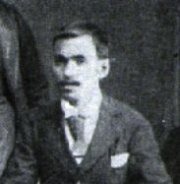
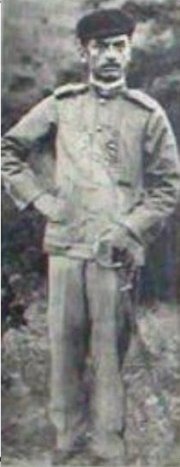
Consequently Quezon was led into the room of Aguinaldo in Malaca�an Palace. A prisoner of war, Aguinaldo told him that Mascardo from thereon was free to decide the matter for himself. [Quezon was elected President of the Philippine Commonwealth in 1935; his chief rival was Aguinaldo, who bitterly protested his defeat].
On May 20, 1901, Mascardo formally surrendered to Col. Andrew S. Burt, CO of the 25th US Infantry Regiment, at San Narciso, Zambales Province, with 17 officers and 215 soldiers with rifles. An acute lack of arms and ammunition prompted Mascardo to give up.
Capt. Joseph P. O’Neil, 25th US Infantry, had previously (May 15, 1901) visited Mascardo’s camp in the mountains and conferred with the Filipino guerilla commander. On May 19, 1901, he escorted General Mascardo and his men to San Narciso, and the surrender was consummated the following day.
Mascardo was born in Kawit, Cavite Province on Oct. 9, 1871. He graduated with a teacher�s diploma from the Escuela Normal de Manila, and then taught in the barrio school of Halang, Amadeo, Cavite. He was elected governor of Cavite for one term 1910-1912, after which he retired to private life. He died on July 7, 1932. He was 60 years old.
June 24, 1901: General Juan Cailles surrenders in Laguna
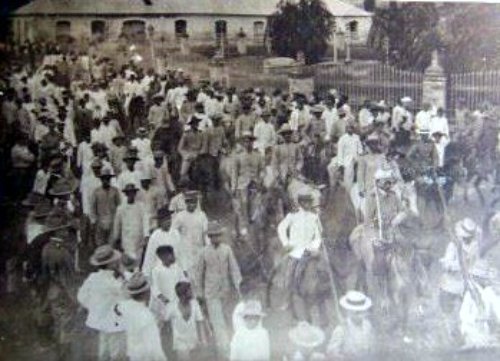
General Juan Cailles surrendered his entire command to Maj. Gen. Samuel S. Sumner on June 24, 1901 in Santa Cruz, Laguna, consisting of 1 general, 1 colonel, 4 lieutenant colonels, 9 majors, 27 captains, 25 first lieutenants, 38 second lieutenants, 507 noncommissioned officers and privates, and 140 civilian officials of various towns and villages of Laguna. He also turned in 400 rifles, 5 cannon and about 4,000 rounds of ammunition.
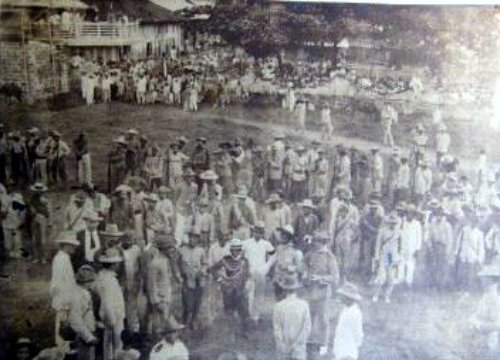
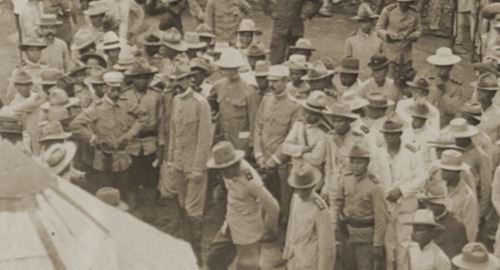
Juan Cailles was born in Nasugbu, Batangas, on Nov. 10, 1871, to Hip�lito Cailles, a Frenchman and Mar�a Kaupama, a woman of Indian extraction. He graduated from the Escuela Normal in Manila and taught for five years in the public schools of Amaya, Tanza, and in Rosario, Cavite. He joined the Katipunan and organized a force of fathers of his own pupils. He took part in many encounters with the Spaniards, particularly in those engagements resulting in the deaths of his superior officers, like Generals Candido Tria Tirona, Edilberto Evangelista, and Crispulo Aguinaldo.
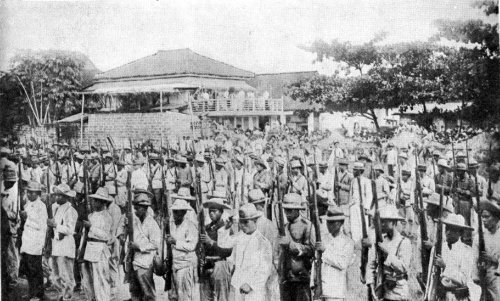
Cailles was appointed by Aguinaldo as military governor of Laguna and half of Tayabas (now Quezon) province. The capture of Aguinaldo in Palanan, Isabela, on March 23, 1901, convinced Cailles that the war was lost, and so he decided to surrender.
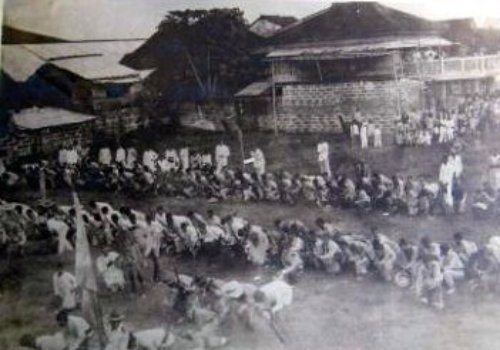

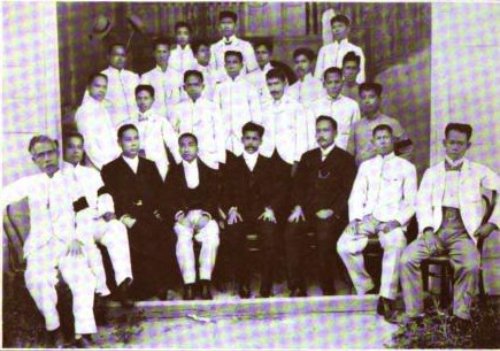
The Americans appointed Cailles governor of Laguna in July 1902 and served until 1910; he reassumed the same post in 1916 and served until 1925, when he was appointed representative of the Mountain Province in the Philippine Legislature. In 1931, Cailles was again elected governor of Laguna, and reelected in 1934.[RIGHT, Cailles in 1903]
It was during his term as governor that the Sakdal uprising flared up on May 2, 1935, in Santa Rosa and Cabuyao, Laguna. The leftist Sakdalistas were poor, landless peasants frustrated with the oppressive land tenancy situation. The revolt was suppressed in record time —-in fact, the following day—- thanks to Cailles� firm administration and revolutionary experience. About 100 Sakdalistas were killed by the Philippine Constabulary in Bulacan Province and Laguna, but the bloodiest encounter took place in Cabuyao were 52 of the rebels died. Cailles had also a hand in hunting down Teodoro Asedillo, �Terror of the Sierra.� The latter was labeled a bandit but revisionist historians consider him a hero of the peasantry. He headed the leftist Katipunan ng mga Anak Pawis (“Association of Toiling Peasants”), an organization linked to the Communist Party. He was cornered and killed in Sampalok, Quezon Province in December 1935.
Cailles died of heart attack on June 21, 1951 at age 79.
July 4, 1901: Maj. Gen. Vito Belarmino surrenders in Albay

At the age of 19, he entered the government service and successively held the positions of teniente mayor, cabeza de barangay, secretary of the local tribunal, and gobernadorcillo. Later, he was appointed Justice of the peace.
He joined the revolution against Spain. In 1896, he, together with Vicente Giron led an attack on the convent and the Spanish guards in Silang. He joined Aguinaldo in the assault against Infantry Battalion No. 72 of the Spanish Army stationed in Talisay, Batangas.

On Oct. 29, 1898, he was placed in command of the province of Albay with orders to establish a republican government there and to assume the position of military commander of both Camarines and Sorsogon provinces.

On Jan. 20, 1900, Brig. Gen. William A. Kobbe’s expeditionary force, comprising the 43rd and 47th Infantry Regiments U.S. Volunteers, and Battery G , 3rd Artillery, took the port of Sorsogon without resistance. The following day, the ports of Bulan and Donsol were occupied by Maj. Hugh D. Wise’s battalion of the 47th, giving the US Army effective control of Sorsogon province. The initial operations following the occupation of the ports soon established American-held enclaves around the towns and left the countryside under the control of the guerillas.

On Jan. 23, 1900 at Legaspi, Albay, Belarmino and General Jose Ignacio Paua put up a strong resistance but in the end had to retreat. On January 24, Virac, Catanduanes Island (then a part of Albay Province), was taken by the Americans without a shot being fired. On February 8, Tabaco, Albay was captured and on February 23, Naga, Camarines fell.

General Paua surrendered on March 27, 1900 to Col. Walter Howe, Commanding Officer of the 47th Infantry Regiment; Belarmino continued to wage guerrilla warfare and repeatedly harassed American installations in the Bicol region.

But with almost no ammunition, Belarmino had to surrender on July 4, 1901.
He went back to Silang, Cavite where he retired into private life. On July 14, 1933, at the age of 76, Belarmino died of a cerebral attack.
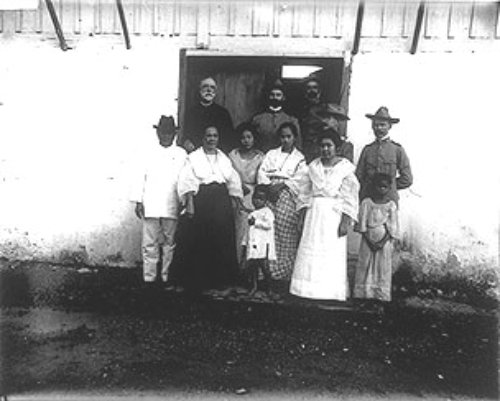
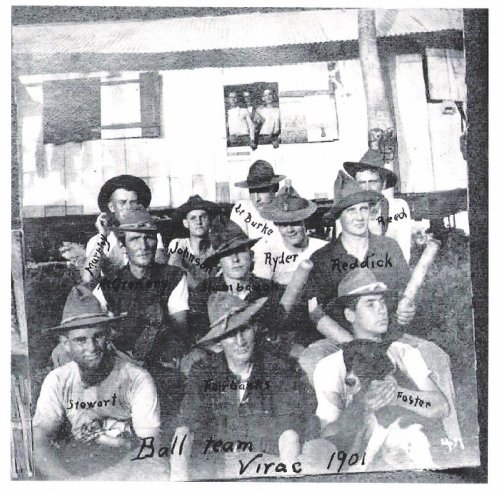
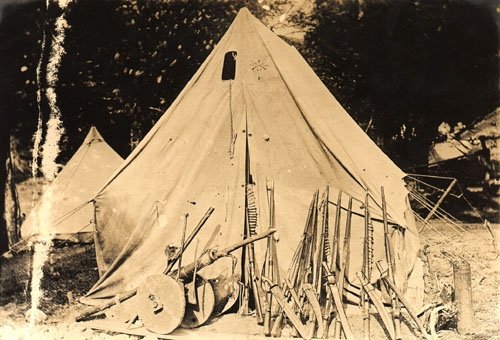
July 4, 1901: Establishment of Civil Government
The first government established by the Americans in the Philippines followed the Spanish surrender in Manila on Aug. 13, 1898. It was a military government. The Philippines was ruled by the president of the United States in his capacity as commander-in-chief of the United States Armed Forces.
On March 2, 1901, the military government in the Philippines ceased to exist when the US Congress enacted the Army Appropriations Act. This law carried the Spooner Amendment, which removed from the US president the final authority to govern the Philippines. This power was to be exercised by the United States Congress through the president.
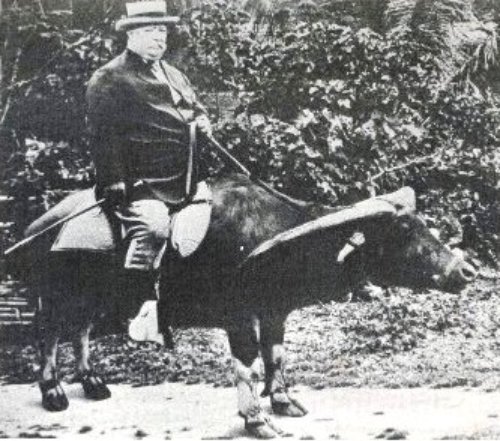

As a result, a civil government was established in the Philippines and inaugurated on July 4, 1901. Judge William H. Taft was the first civil governor. (In 1905, the title was changed to governor general).
Taft was born on Sept. 15, 1857 in Cincinnati, Ohio. He graduated as class salutatorian from Yale College in 1878, studied law in Cincinnati College and was admitted to the Ohio bar in 1880. In 1890, he was appointed solicitor-general of the United States by President Benjamin Harrison. In 1892 he was appointed a judge of the Sixth Circuit, United States Court. In 1896-1900 Judge Taft was professor and dean of the law department of the University of Cincinnati.

In 1900 he was asked by President William Mckinley to accept the presidency of the Second Philippine Commission charged with the administration of the colony. Though he had been opposed to the acquisition of the Philippines, he did not believe that the Filipinos were capable of self-government. However, he accepted and served from March 13, 1900 to Feb. 1, 1904.
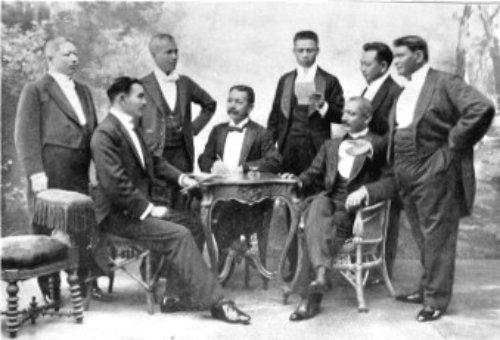
On the establishment of civil government in the country on July 4, 1901, he became civil governor, ex officio. Taft advocated a more repressive policy of pacification than that conceived by the U.S. military. He pushed for the deportation of captured resistance leaders to Guam, and he wanted Filipinos refusing to lay down their arms to be “treated as outlaws and subject to the severest penalties.” Taft criticized Maj. Gen. Arthur C. MacArthur, Jr., for being “much too merciful in commuting death sentences” of convicted “terrorists”. In his private correspondence, he showed little respect or liking for the Filipinos.
Taft told President McKinley that “our little brown brothers” would need “fifty or one hundred years” of close supervision “to develop anything resembling Anglo-Saxon political principles and skills.”
He became U.S. Secretary of War from Feb. 1, 1904.

Taft visited the Philippines and arrived at Manila on Aug. 5, 1905 (ABOVE). The visit was part of the first and largest U.S. foreign diplomatic delegation to Asia; the three-month goodwill tour embarked from San Francisco on July 8, 1905 and stopped in Japan, the Philippines, and China. Led by Taft, the 83-person entourage comprised 35 congressmen, 7 senators, and a group of civilians including Alice Lee Roosevelt, daughter of President Theodore Roosevelt and the media darling of the era.
[In Tokyo, on July 27, Count Taro Katsura, the Japanese premier and Taft agreed to a secret arrangement that would allow the Japanese to dominate Korea in exchange for Japan�s promise to stay away from the Philippines.]
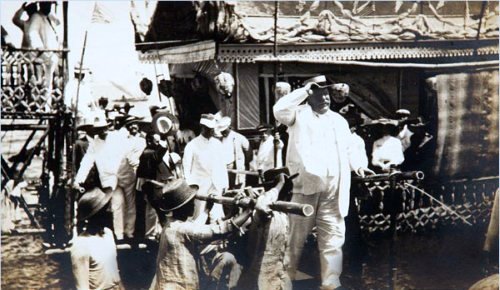
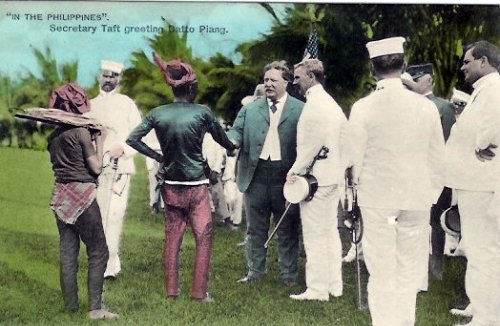

Taft again visited the Philippines to open the First Philippine Assembly on Oct. 16, 1907 (ABOVE, with Governor-General James E. Smith).

Taft won the U.S. presidential election on Nov. 3, 1908, and was inaugurated on March 4, 1909. He failed to get reelected in 1912 and served out his term in 1913.
After a professorship at Yale, Taft finished his years as Chief Justice of the US Supreme Court, appointed by President Warren G. Harding on July 11, 1921.
Suffering from heart disease, he resigned on Feb. 3, 1930 and died the following month, on March 8, 1930.
In Manila, Philippines, Taft Avenue is named after him.
Sept. 4, 1901: American Deserter, Arthur Howard, Is Caught
Sept. 27, 1901: George A. Raymond, White American bandit, is hanged
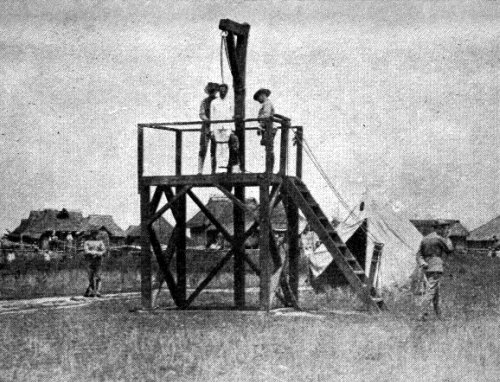
Brig. Gen. Frederick Funston tells the strange case of ex-Pvt. George A. Raymond in his book, “Memories of Two Wars: Cuban and Philippine Experiences” (published in 1911):
“We had not been in San Fernando very long when there began to be noised about rumors of the presence of a white bandit operating in the country thereabouts. This was more than interesting, being without precedent in our times in the Philippines, and the matter was looked into. Finally, the suspected man was arrested, and proved to be George A. Raymond, a recently discharged soldier of the Forty-first Infantry…..Raymond, having already been discharged from the army, was not subject to trial by court-martial, and so was sent before a military commission, which is the same thing, only worse….. Raymond was convicted of murder, robbery, and another crime that cannot be mentioned here; and on the 27th day of September…..despicable criminal though he was, had the good taste not to lower the prestige of his race in the way he met death, and, defiant to the last, went to his doom with sullen courage.”
Raymond was sentenced to death for robbing and killing ex-comrade Henry Bohn of his final pay as a soldier; robbing a Filipino, Jose de Jesus, of two saddles and bridles and three horses; and raping a Filipina, Roberta Rivera.
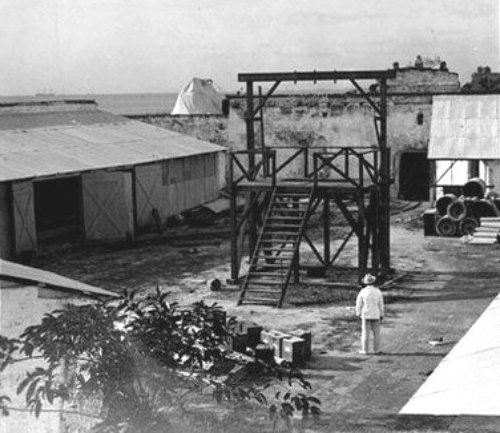
A week earlier, on September 20, Harry Cline, an American civilian employee of the U.S. Army Quartermaster’s Department, was hanged at Fort San Antonio de Abad, Manila, for the brutal and senseless murder of a Filipino boy. On April 8, 1901, he rode out on a bicycle some 3 miles from Paranaque. He saw four small Filipino boys gathering grass. The charge sheet read: “With no other apparent motive than natural depravity, he proceeded to shoot these boys with his revolver, wounding three and killing the fourth.” The fatality was Agaton Rivera.
U.S. military commissions hanged some 300 Filipinos and 6 American criminals.

